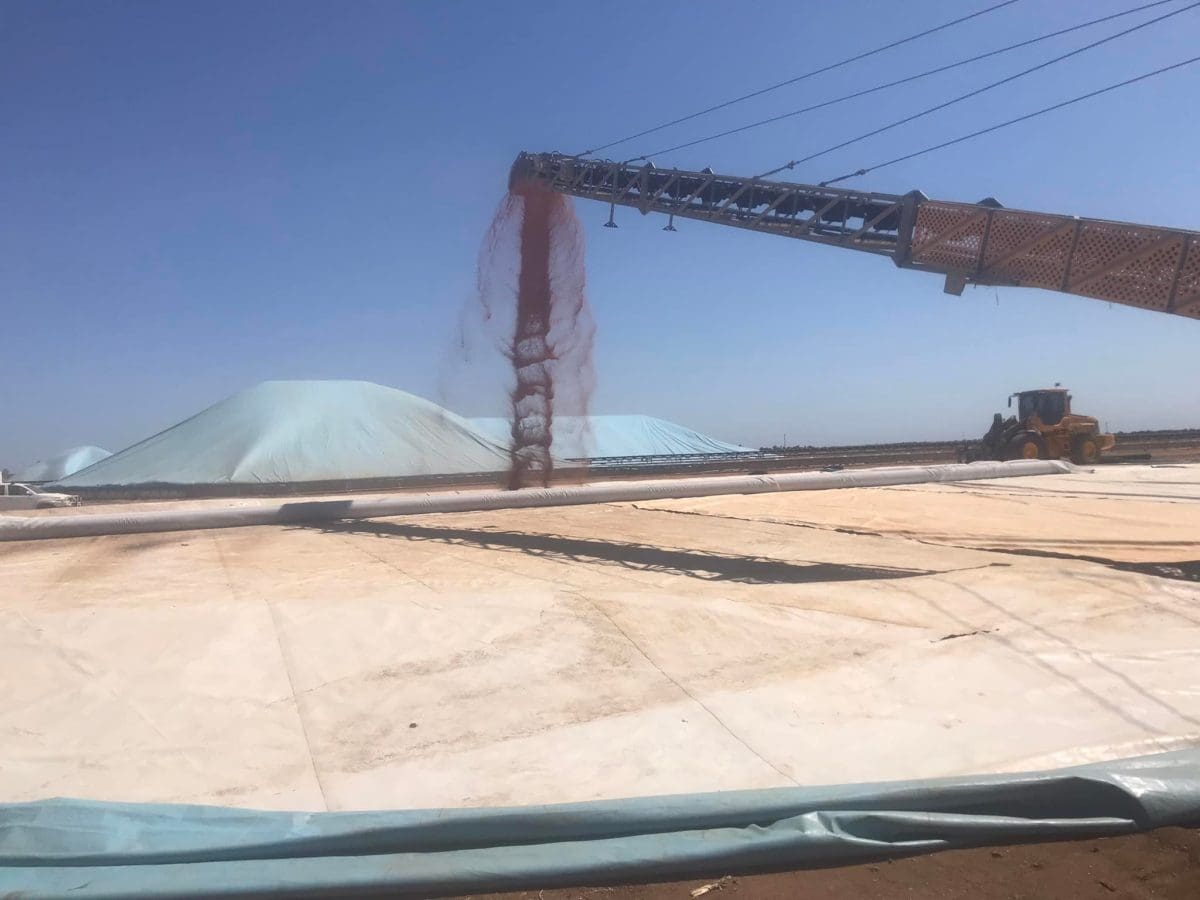
Sorghum drops into GrainCorp’s first sorghum stack for this harvest at Mt McLaren in Central Queensland. Photo: Ross Faint
WHEAT and barley prices in the northern market have traded steady to $2 per tonne dearer in the past week, while southern prices have jumped again on the transport squeeze exacerbated by the extended closure of the main grain line into Port Kembla.
This is the last five-day working week ahead of three short weeks which include Good Friday, Easter Monday and Anzac Day, and a number of consumers and export accumulators are covering last-minute needs ahead of the holiday period.
Trade sources say consumers booked adequate coverage some time ago, but COVID’s impact on the workforce coupled with rain delays and additional carting demands caused by the Riverina rice harvest, as well as the Port Kembla situation, have created some shorts.
“Chickens don’t eat paper,” one trader said.
| Today | Mar 31 | |
| Barley Downs | $360 | $358 |
| SFW wheat Downs | $390 | $390 |
| Sorghum Downs | $350 | $335 |
| Barley Melbourne | $400 | $390 |
| ASW wheat Melbourne | $420 | $408 |
| SFW wheat Melbourne | $405 | $400 |
Table 1: Indicative delivered prices in Australian dollars per tonne.
North gets by
In Queensland and northern New South Wales, showers and storms have been rolling through to delay the sorghum harvest in some areas.
Rainfall registrations in Queensland in the week to 9am today include: Dalby 7mm; Felton 59mm; Roma 22; Springsure 10mm, and Surat 11mm.
Falls in northern NSW included: Moree 2mm; Mungindi 45mm; Narrabri 12mm; Tamworth 26mm, and Warialda 20mm.
A major flood warning has been issued for the Condamine and Balonne Rivers in southern Queensland, and some short-lived road closures are expected.
Sorghum-growing regions also produce cotton, and early crops in Central Queensland are already being picked.
Stewarts Grain trader Robert Quinn said the impending cotton harvest was expected to shrink the already limited supply of trucks.
“The grain market’s probably a little bit firmer, and the biggest problem is execution; everything’s hard,” Mr Quinn said.
“Anyone who wants to do business has to pay a bit of a premium to justify the effort.”
Mr Quinn said a wave of inquiry this and last week indicated cattle from drier areas of Queensland were going into feedlots, and some business was being done ahead of the cotton season.
“Once the cotton harvest starts, a lot of trucks will disappear from grain.
“There’ll be bales going into the gins, and seed and lint going out.”
Mr Quinn said feedlot demand was split fairly evenly between SFW wheat and barley, with some on one only, and others on a mixture.
He said adequate rain had fallen in most areas to allow growers to start thinking about planting their winter crop in northern NSW.
“In another four weeks, the growers will disappear because they’ll be busy with planting, and they won’t want to be loading trucks.”
Traders report the poultry market is buying dribs and drabs of downgraded chickpeas and sorghum, and top-grade sorghum is flowing at pace into Brisbane’ bulk export terminals, and also into containers.
South squeezed
Little to no rain fell in major Victorian and South Australian grain-growing regions, and in central and southern NSW, while in Western Australia, falls of 5-40mm were recorded in most cropping districts.
It means growers, most of whom have secured all their inputs for the upcoming plant, are rapidly losing interest in selling warehoused or on-farm grain.
Peters Commodities trader Peter Gerhardy said the firming in prices was tied to logistics, with the extended period of limited rail access into Port Kembla the latest development.
“There are exorbitant freight rates being thrown around to counteract the rail problem,” Mr Gerhardy said.
“That’s causing issues into that port zone, there’s no two ways about it.
“Pricing is very very firm, and a lot is based on logistics.”
Domestic consumers appear to be keen to buy wheat, and trade sources report all grades are in strong demand for export and domestic markets now that growers are focussing on preparation for planting.
“Growers either want to move it now, and have it paid for immediately, or they don’t want to sell,” one trader said.
This minimal engagement from growers is at odds with the trade’s desire to get more tonnes on boats.
“There are still exceptional margins in shipping wheat.”
The Riverina rice harvest, which has about three weeks left to run, and the impact of COVID-19 on the workforce, is limiting the number of grain trucks available.
“There’s a lack of drivers, and labour everywhere feels very tight.”
Some bids at $10-$20/t delivered site above the market are popping up, and traders say this indicates contracts have been difficult to execute because of the truck shortage.
“That tells me people have been let down,” another trader said.
Barley offers are hard to find among the trade and from the grower, and barley is priced at an unusually small discount to SFW wheat of just $5/t in the south, compared with $30/t in the north.
